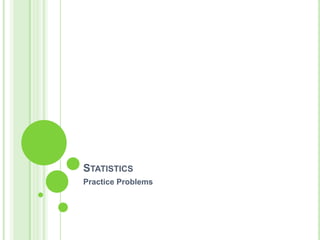
Appendix 2 Statistics Power Point
- 2. Five-Number Summary Find the five-number summary for this set of data 47, 56, 89, 43, 21, 90, 74, 1066, 109, 756, 947, 12, 130
- 3. Five-Number Summary (Cont.) Find the five-number summary for this set of data 47, 56, 89, 43, 21, 90, 74, 1066, 109, 756, 947, 12, 130 To solve, first put in order by value: 12, 21, 43, 47, 56, 74, 89, 90, 109, 130, 756, 947, 1066 Minimum: 12 First Quartile: 45 Median: 89 Third Quartile: 443 Maximum: 1066
- 4. Histogram Create a histogram for this set of data 47, 56, 89, 43, 21, 90, 74, 1066, 109, 756, 947, 12, 130
- 5. Histogram (Cont.) Create a histogram for this set of data 47, 56, 89, 43, 21, 90, 74, 1066, 109, 756, 947, 12, 130 To solve, first create a frequency table: For this problem, let’s use 8 bars in the histogram First, find the range of the data Maximum: 1066 – Minimum: 12 = Range: 1054 Then, divide by the desired number of bars Range: 1054 ÷ 8 = 131.75 (about 135) Finally, create the frequency table (see next slide)
- 6. Histogram (Cont. II) Create a histogram for this set of data 47, 56, 89, 43, 21, 90, 74, 1066, 109, 756, 947, 12, 130 Completed Frequency Table:
- 7. Histogram (Cont. III) Create a histogram for this set of data 47, 56, 89, 43, 21, 90, 74, 1066, 109, 756, 947, 12, 130 Next, create the histogram 10 9 8 7 6 5 4 3 2 1 1 0-135 136-271 272-407 680-815 544-679 816-951 952-1087 408-543
- 8. Box and Whisker Plot Create a box and whisker plot for this set of data 47, 56, 89, 43, 21, 90, 74, 1066, 109, 756, 947, 12, 130
- 9. Box and Whisker Plot (Cont.) Create a box and whisker plot for this set of data 47, 56, 89, 43, 21, 90, 74, 1066, 109, 756, 947, 12, 130 To solve, first find any outliers: First, find the inter-quartile range of the data Third Quartile: 443 – First Quartile: 45 = Inter-quartile Range: 398 Then, multiply by 1.5 Inter-quartile Range: 398 × 1.5 = 597 Next, add this number to the third quartile and subtract it from the first quartile Third Quartile: 443 + 597 = 1040 First Quartile: 45 – 597 = -552 Finally, find any outliers -552 ≤ (accepted numbers in set of data) ≤ 1040 < 1066
- 10. Box and Whisker Plot (Cont. II) Create a box and whisker plot for this set of data 47, 56, 89, 43, 21, 90, 74, 1066, 109, 756, 947, 12, 130 Create the plot Draw a number line Mark the median and quartiles Draw lines out to the minimum and maximum (excluding any outliers) 45 443 89 12 947 100 0 200 300 400 500 600 700 800 900 1000 1100